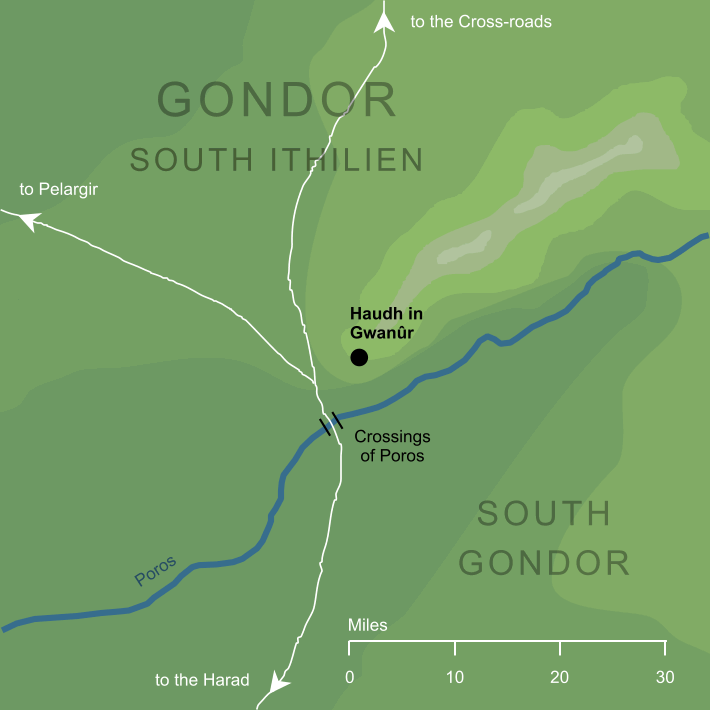
The mound of the Haudh in Gwanûr (slightly conjectural)2
The mound of the Haudh in Gwanûr (slightly conjectural)2
The mound raised on the banks of the Poros by the Men of Rohan to entomb their lords Folcred and Fastred, twin sons of Folcwine slain in battle with Harad.
Rohan had suffered invasion during the Long Winter, and had only survived through the help of Beregond of Gondor. It took the Rohirrim more than a century to recover fully from the privations of that time, and also from the Orcs who had descended on their land in later years, but by the time Folcwine became King of Rohan, the land had returned to its former strength.
In Folcwine's time, it was his allies the Gondorians who suffered, with their eastern province of Ithilien overrun by Orcs out of Mordor, and their southern borders threatened by the Haradrim. Remembering the Oath of Eorl and the aid sent by Beregond, Folcwine was ready to lead out his army to aid in the defence of Gondor. The King had been a great warrior in his youth - he had reclaimed the West-march for Rohan from the Dunlendings - but at this time he was fifty-five years old. He was instead persuaded to allow his sons to lead the Riders of Rohan to the help of Gondor.
These sons of Folcwine were twin brothers named Folcred and Fastred, who rode off to join the forces of Steward Túrin II on the southern borders of Ithilien. Folcwine also had a daughter and a third son, Fengel, but at this time (the year III 2885) Fengel was just fifteen years old, and so remained with his father in Rohan.
The southern border of Ithilien was formed by the river Poros, and at the Crossings of this river, the Gondorians and the Rohirrim joined battle against the Haradrim. The fighting was fierce, but the invading force from the south was defeated. The twin brothers Folcred and Fastred were both slain, fighting side by side until the end. Their Riders honoured them in the traditional manner of their people, raising a great burial mound on the high land beside the river. That mound was named in Elvish Haudh in Gwanûr, the mound of the twin brothers.
Steward Túrin sent Folcwine a rich weregild in recompense for the loss of his sons, and in recognition of the part they had played in saving Gondor from the invading Haradrim. With the deaths of his elder sons, the line of descent fell on his youngest son Fengel, and when Folcwine died eighteen years later, Fengel became the King of Rohan. Fengel would become the grandfather of Théoden, so the loss of Fastred and Folcred had a direct and important impact on the history of Rohan.
As for the mound itself, it stood for many years3 looking down on the Crossings of Poros, and even in death the twin brothers guarded the lands to the north. While the Haudh in Gwanûr watched over the Fords, their victory over the Haradrim was not forgotten, and the enemies of Gondor beyond the river Poros were said to fear to pass the great mound of Haudh in Gwanûr.
Notes
1 |
The Sindarin word gwanûr derived from elements that combined to literally mean 'born together', and were normally applied to family relations. In The Etymologies in volume V of The History of Middle-earth the word is defined simply as 'brothers', but in later notes (in Quendi and Eldar in volume XI) the meaning seems to have shifted to 'twins', while other sources give it as a dual plural, 'pair of twins'. Folcred and Fastred were twin brothers, so either meaning might apply in the case of Haudh in Gwanûr.
In earlier editions of The Lord of the Rings, the word is spelt gwanur (that is, without a circumflex accent). This was presumably a simple typographical error, but the effect was to make the word singular instead of plural (that is, Haudh in Gwanur without the accent would mean 'mound of the brother' or 'mound of the twin').
|
2 |
While we know that the Haudh stood at the Crossings of Poros, we're not told exactly where it lay in relation to the Crossings, nor is it shown on any map. A comment in Appendix A to The Lord of the Rings places it 'high upon the shore of the river', and accordingly the map above places it in the higher land we know ran eastward from the Crossings, though this location is necessarily speculative.
|
3 |
In the chronicles represented by Appendix A to The Lord of the Rings, the mound is described in the past tense, which seems to imply that the it did not stand indefinitely above the Fords of Poros. We are given no hint about what might have happened to the mound; it may simply have crumbled with time, or (if the Haradrim feared it as strongly as we are told) they may have removed the mound to aid their journey northward during the War of the Ring.
|
Indexes:
About this entry:
- Updated 22 March 2022
- This entry is complete
For acknowledgements and references, see the Disclaimer & Bibliography page.
Original content © copyright Mark Fisher 2000-2001, 2016-2017, 2022. All rights reserved. For conditions of reuse, see the Site FAQ.

